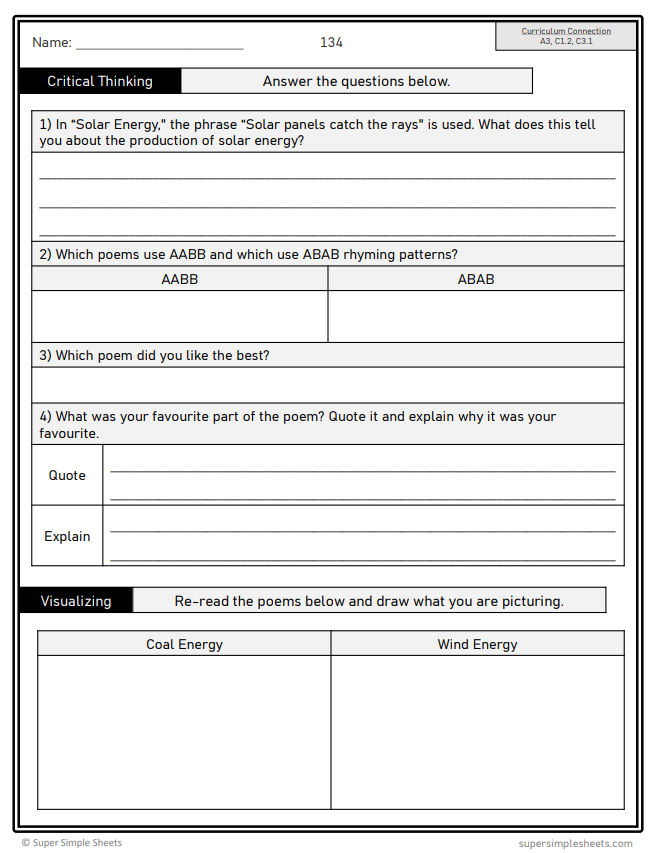Grade 6 - Reading Comprehension Unit - Ontario Language - Lesson/Workbook Bundle
Grade 6 - Reading Comprehension Unit - Ontario Language - Lesson/Workbook Bundle
Interested in a bundle? Shop below instead!
Couldn't load pickup availability
Grade 6 - Reading Comprehension Unit - Ontario Language Curriculum - Lesson/Workbook Bundle. This bundle was created to provide everything you need to teach the Grade 6 Reading Comprehension unit in the Ontario Language Curriculum.
With your purchase, you will receive lesson slides that follow the 3-Part lesson format, engaging your students from start to finish. You will also receive the workbook, which contains fun activities and worksheets for your students to demonstrate their understanding.
Workbook Details:
This resource covers all expectations and learning goals in the Grade 6, 2023 Ontario Language Curriculum – Reading Comprehension Strand.
There are 276 activity sheets that align to cover all expectations in the NEW Ontario 2023 Language Curriculum. These activities can be used on their own, or to compliment the Composition Strand. Students will learn each of the expectations as they progress through the different text forms that follow the same pattern as the Composition unit.
We’ve included a variety of activities, including independent reading responses, group activities, assignments, experiments, and hands-on activities to keep your students engaged.
Included in this unit are the overall expectations:
C1. Knowledge about Texts – taught using 10 different text forms, including poetry, persuasive writing, and reports.
C2. Comprehension Strategies – we’ve included a stand-alone independent reading comprehension package (BINGO and other responses), and these strategies are taught throughout the 276-page unit.
C3. Critical Thinking in Literacy – taught throughout the resource (biases, inferences, literary devices, etc.)
We have also covered Strand A in Language - Literacy Connections and Applications. We have included curriculum connections for all our activities, so you can see exactly what you will be covering by completing each activity. We know this will help when writing report cards!
In addition, we have included a full-year long range plan that outlines what concepts from the curriculum you will be teaching each week/block.
Some of the concepts covered:
- What is reading comprehension?
- Before reading: comprehension strategies – activating prior knowledge and reasons for reading
- During reading: comprehension strategies – questioning, making connections, inferences, predictions, visualizing
- After reading: comprehension strategies – summarizing, making global and local inferences, visualizing
- Activity – goal setting for using comprehension strategies
- Cultural text forms – creation stories and songs
- Letter writing – emails, formal and informal letters, bias
- Implicit and explicit perspectives in letter writing
- Voice in writing – use of cohesive ties and different sentence structures
- Activity - determining the voice used in popular songs
- Narratives – use of literary devices: hyperbole, idiom, alliteration, metaphor
- Perspective in narratives – first-person, second-person, and third-person and advantages/disadvantages of each
- Narratives – sequencing multiple plots in a story and explaining cause and effect
- Indigenous Storywork – 7 Principles: respect, responsibility, reciprocity, reverence, holism, interrelatedness, synergy
- Indigenous storytelling – histories, creation stories, culture, and relationships
- Cross-curricular connections – text forms related to themes in science and social studies (electricity, USMCA)
- Persuasive writing – using critical thinking skills to determine bias
- Finding implicit and explicit evidence in persuasive texts
- Text features in reports – headings, subheadings, pull-down menus, hyperlinks, captions, tables, graphs, etc.
- Reports on diversity, inclusion, and accessibility
- Activity – Determining the quality of information when researching online
- Use of graphs, maps, diagrams, and pictures in reports
- Literary devices used in poetry – idioms and hyperbole
- Assignment – dissecting poems written by Indigenous authors
- Understanding haiku, limericks, acrostic poems, cinquain poems, and rhyming poems
- Bias in book reviews
- Activity: detecting bias in online reviews
- Reading different styles (voices) in book reviews
- Text features in comics, infographics, memes, and maps
- Text features in biographies – using a glossary and a preface to understand a biography
- Chris Hadfield, Elijah Harper, and David Suzuki biographies with prefaces and glossaries
- Answer pages for all activities
Google Lesson Slides
Grade 6 - Reading Comprehension Unit - Google Lesson Slides - Ontario Language Curriculum. This resource is packed with all the lessons you need to teach the Reading Comprehension, Grade 6, Ontario Language New 2023 Curriculum.
We have structured these lessons to follow the popular 3-Part Lesson format. By using these lessons, you will be provided with learning goals, discussion questions, relevant YouTube videos, interactive slides, exit cards, and more. Check out the variety of activities you'll receive below.
Part 1: Minds On!
- Learning Goals
- Discussion Questions
- Quotes
Part 2: Action!
- Interactive Activities
- Drag and Drop
- Fill in the Blanks
- Matching
- Drawing
- Writing
Part 3: Consolidation
- Exit Cards
- Quizzes
- Reflection
After purchasing this resource, you will be able to download a copy of this file to your Google Drive. From there, you can complete these lessons with your class, and/or assign these slides in Google Classroom.
Share















